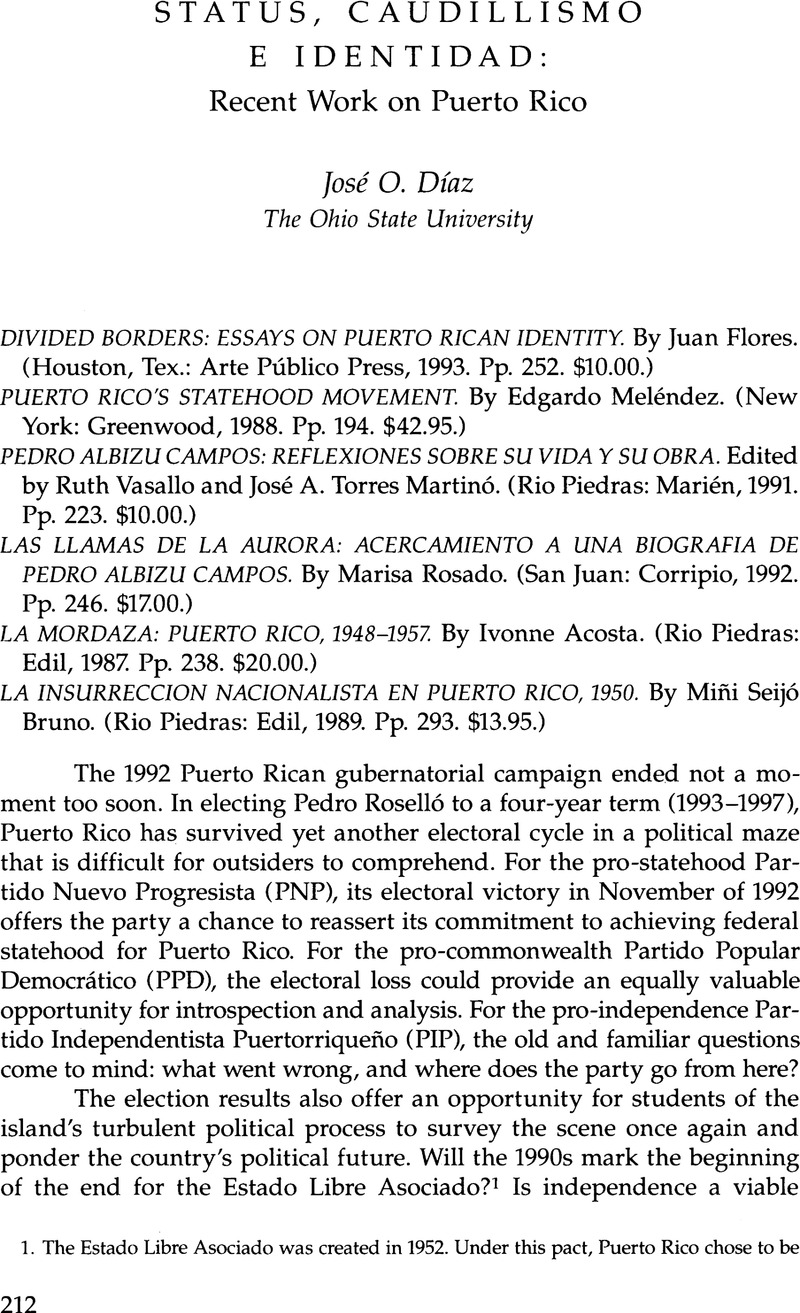No CrossRef data available.
Published online by Cambridge University Press: 05 October 2022

1. The Estado Libre Asociado was created in 1952. Under this pact, Puerto Rico chose to be associated with, but not form part of, the United States. The island possesses some powers of local self-government, is included in certain federal programs, and is exempted from federal taxes. Detractors reject the Estado Libre Asociado as a vestige of U.S. colonial policy.
2. See Ronald Fernández's Los Macheteros: The Wells Fargo Robbery and the Violent Struggle for Puerto Rican Independence (New York: Prentice Hall, 1987).
3. The Cerro Maravilla murders involved the entrapment and murder of two young pro-independence activists by members of a Puerto Rican police intelligence unit in the remote mountain site of Maravilla. See Anne Nelson, Murder under Two Flags: The U.S., Puerto Rico, and the Cerro Maravilla Cover-Up (New York: Ticknor and Fields, 1986); and Manuel Suárez, Requiem on Cerro Maravilla: The Police Murders in Puerto Rico and the U.S. Government Cover-Up (Maplewood, N.J.: Waterfront, 1987). The movie was released by Paramount under the title A Show of Force (a John Strong production in association with Golden Harvest, 1990).
4. A good place to begin any study on Puerto Rico is with the seminal work of the late Gordon K. Lewis, Puerto Rico: Freedom and Power in the Caribbean (New York: Monthly Review Press, 1963).
5. These essays were published as part of larger collections of essays. See José Luis González, El país de cuatro pisos y otros ensayos (Río Piedras, P.R.: Huracán, 1980); and Antonio S. Pedreira, Insularismo: ensayos de interpretación puertorriqueña (Madrid: Tipografía Artística, 1934).
6. See Raymond Carr, Puerto Rico, A Colonial Experiment (New York: New York University Press, 1984).
7. See The Political Status of Puerto Rico, edited by Pamela Falk (Lexington, Mass.: Lexington, 1986); The Puerto Rican Question, edited by Jorge Heine (New York: Foreign Policy Association, 1983); and Puerto Rico: The Search for National Policy, edited by Richard Bloom-field (Boulder, Colo.: Westview, 1985).
8. See Carlos Romero Barceló, La estadidad es para los pobres (San Juan: Romero-Barceló, 1976); published in English as Statehood Is for the Poor (San Juan: Romero-Barceló, 1976).
9. The twin-plant program was part of an economic strategy that proposed the procurement and initial processing of certain products in wage-depressed zones of the Caribbean, followed by finishing the products in Puerto Rico, the most advanced economy in the region.
10. The politics of redemption was based on a governing philosophy aimed at attaining social stability through the use of state programs and political stability by integrating Puerto Rico further into the U.S. social and economic milieu.
11. Santaliz stated in a 1989 speech, “Don Pedro Albizu Campos partió la historia del siglo veinte en Puerto Rico. Con todo rigor este siglo se divide en antes y después de la aparición de Albizu Campos.” José Enrique Ayoroa Santaliz, “Un hito en nuestra historia,” speech given at the University of Puerto Rico College of Law, 19 Nov. 1989.
12. Editorial, San Juan Star, 2 Apr. 1965, p. 25.
13. José Ferrer Canales, “Albizu Campos y José Martí,” and Manuel Maldonado Denis, “Sandino y Albizu Campos,” both in Claridad: Suplemento en Rojo (San Juan), Sept. 1982, pp. 10–26.
14. The remark was made by Carlos Gallisá, General Secretary of the Partido Socialista Puertorriqueño (PSP), during a televised hearing before the Subcommittee on Insular and International Affairs of the Committee on Interior and Insular Affairs, U.S. House of Representatives. The hearings were held in March 1990 in Washington, D.C., and in the Puerto Rican cities of San Juan, Ponce, and Mayaguez.
15. See Antonio M. Arroyo Stevens, The Political Philosophy of Pedro Albizu Campos: Its Theory and Practice (New York: New York University Press, 1974).
16. The Jones Act granted U.S. citizenship to Puerto Ricans and reformed the local legislature.
17. Arturo Morales Carrión, Puerto Rico and the United States: The Quest for a New Encounter (San Juan: Editorial Académica, 1990).
18. Ibid., 84.